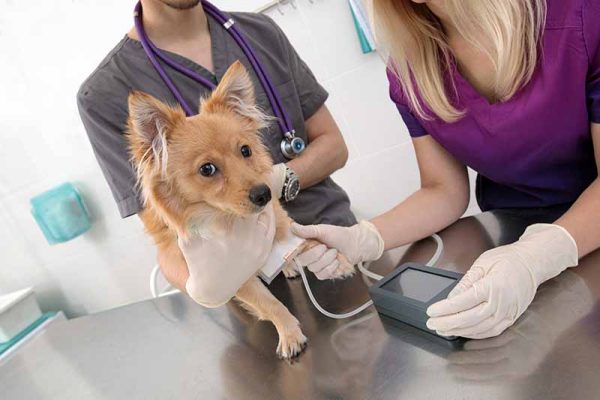Dogs and humans have a long shared history, but how alike are we really? When the structure of DNA was discovered and we gained the ability to sequence both human and animal genomes, it was no great surprise to learn that we had a lot in common with our animal friends. Humans and animals share a gigantic amount of genetic material in common. The fact that we share copious amounts of DNA with apes is understandable. Even predictable. But the truth is, we also share vast amounts of DNA with other non-primates. In fact, you may be surprised to know that dogs share 84% of our DNA! This is slightly more than the 80% that we share with mice and far less than the 98% that we share with chimps.

What Is DNA?
Deoxyribonucleic acid (DNA) is an organic molecule found in the nucleus of cells. It contains the genetic instructions for all living organisms. DNA is the molecule that encodes genetic information in cells and is made up of adenine, cytosine, thymine, and guanine. DNA molecules are highly stable since they’re made up of two complementary strands that form a double helix. During cell division, DNA duplicates itself and creates proteins, which are essential for many physical functions.

What Is a Genome?
Genomes are sequences of DNA that contain all the genetic instructions needed to build and maintain living things, including humans. The genome is the complete set of genes present in an organism. It contains all hereditary traits and determines what physical and behavioral features an organism will have. About 20,000 genes make up a genome, which is comprised of DNA sequences that code for proteins.
What Is DNA Sequencing?
Nucleotides are organic molecules that form the structures for genes and proteins. DNA sequencing is a technique used to determine the sequence of nucleotides in a DNA molecule. To do this, a DNA molecule is cut into smaller pieces and then used as a template for a particular strand of RNA that has been copied from the DNA’s matching complementary strand. This RNA is then able to match up with each piece of DNA and can be read off slowly, one letter at a time.
The most accurate way to identify exactly what percentage of DNA is shared by two species is to compare their complete DNA sequences (or genomes) with each other. However, determining the entire DNA sequence of an animal is a difficult task that takes significant time and effort. It requires a great deal of equipment, resources, and funding to do so.

When Was the Human Genome Sequenced?
In 2001, after 10 years of research, a complete human genome was published for the first time. Even though genetic technologies have become much cheaper, faster, and better since then, sequencing the DNA of a species still remains a challenge. Each year, new animal genomes are being studied, sequenced, and added to our body of knowledge of life on this planet.
When Was the Dog Genome Sequenced?
The dog genome was first sequenced in 2005—the particular animal chosen was a purebred female Boxer named Tasha. In general, the dog genome can be seen as a blueprint for building the dog’s genetic material—all the traits and behaviors that are exhibited by a dog are determined by the order and content of its genes. The mapping of the canine genome in 2005 was a landmark in understanding this animal’s biology since it provided insight into their evolutionary history and their relationship with humans.
Do You Need a Whole Genome to Understand How Related Two Animals Are?
You do not need to have sequenced the whole genome of two creatures to get a general sense of how related they are. As a matter of fact, scientists were already putting together predictions on how closely related humans were to other animals long before any genomes had even been sequenced. This is because it is possible to estimate how similar the DNA of the two species is without even knowing the complete sequence of their DNA.

Why Do Scientists Compare the Genomes of Different Species?
Scientists often compare genomes of different species to determine if there is a common ancestor, or if one species is genetically closer to another. A comparison between humans and Neanderthals, for example, may be appropriate because it is hypothesized that humans descended from Neanderthals. Scientists use the comparison to infer ancestry and evolution. Studying genomes can help researchers understand how genes influence traits. Comparing human genes with similar animal genes can help determine their function. We can then use this information to learn about diseases in that species and also in humans.
What Do Similarities & Differences in DNA Teach Us?
We can also learn about evolution by examining the similarities or differences in DNA between species, and as a result, we can see which genes remain the same and which change over time. Comparing DNA tells us about the evolution of our species. As life forms evolve, their DNA changes. Mutations, which occur when DNA replicates, cause these changes. A similarity can suggest a close relationship between two organisms, and can also tell us if two organisms share a common ancestor.

What Have We Learned About Dogs & Humans Through DNA Research?
Dogs and humans share 84% of their DNA, which makes dogs ideal animals for studying human disease processes. Researchers are especially interested in diseases that affect both dogs and humans—humans and their canine friends are both affected by retinal disease, cataracts, and retinitis pigmentosa. Scientists study and research treatments for these diseases in dogs in the hope that they will be beneficial for humans as well.
Dogs are also being studied and treated for cancer, epilepsy, and allergies, in order to develop a more successful treatment for humans. It’s interesting to note that more than 58% of genetic diseases present in dogs are direct equivalents of human diseases caused by mutations in the same genes.

Two instances of canine domestication occurred between 10,000 and 30,000 years ago when humans tamed wolves and turned them into dogs of various breeds, keeping the ones with the highest degree of sociality for further breeding. We now know that some of the genes associated with social behavior are shared by dogs and humans, and through the study of canine models, scientists hope to gain a better understanding of certain social disorders in humans.

Are Cats or Dogs More Closely Related to Humans?
In both cases, these creatures have evolved a high level of intelligence that has enabled them to live alongside humans for centuries. Although you might think that dogs are closer to humans in terms of evolution, it turns out that cats actually share 90.2% of our DNA. Although you may feel that dogs understand us more deeply, it is cats that are, surprisingly, genetically closer to us.
Our closest relatives are the great apes of the family Hominidae. Orangutans, chimpanzees, gorillas, and bonobos belong to this family. Humans share 98.8% of their DNA with bonobos and chimpanzees, while gorillas and humans have 98.4% of the same DNA. However, the differences in DNA increase once we begin looking at apes that are not native to Africa. For example, only 96.9% of the DNA in humans and orangutans is the same. As the closest living relatives of humans, chimps and bonobos have been studied extensively in different research settings.

Final Thoughts
In conclusion, animal DNA research is an emerging field that will provide incredible insight into the evolution of life on this planet. If you feel close to your dog, it’s no surprise! Canines and hominids have co-evolved together for millennia, and you share a whopping 84% of your DNA with your pet. Dogs already do so much for us, and now the sequencing of dog DNA is giving scientists new perspectives on research in disease, genomics, genetics, and evolution.
Featured Image Credit: Daniel Myjones, Shutterstock


















